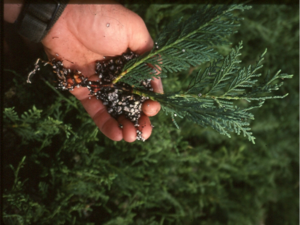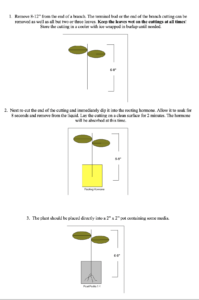Create Your Own Plants From Cuttings
go.ncsu.edu/readext?784156
en Español / em Português
El inglés es el idioma de control de esta página. En la medida en que haya algún conflicto entre la traducción al inglés y la traducción, el inglés prevalece.
Al hacer clic en el enlace de traducción se activa un servicio de traducción gratuito para convertir la página al español. Al igual que con cualquier traducción por Internet, la conversión no es sensible al contexto y puede que no traduzca el texto en su significado original. NC State Extension no garantiza la exactitud del texto traducido. Por favor, tenga en cuenta que algunas aplicaciones y/o servicios pueden no funcionar como se espera cuando se traducen.
Português
Inglês é o idioma de controle desta página. Na medida que haja algum conflito entre o texto original em Inglês e a tradução, o Inglês prevalece.
Ao clicar no link de tradução, um serviço gratuito de tradução será ativado para converter a página para o Português. Como em qualquer tradução pela internet, a conversão não é sensivel ao contexto e pode não ocorrer a tradução para o significado orginal. O serviço de Extensão da Carolina do Norte (NC State Extension) não garante a exatidão do texto traduzido. Por favor, observe que algumas funções ou serviços podem não funcionar como esperado após a tradução.
English
English is the controlling language of this page. To the extent there is any conflict between the English text and the translation, English controls.
Clicking on the translation link activates a free translation service to convert the page to Spanish. As with any Internet translation, the conversion is not context-sensitive and may not translate the text to its original meaning. NC State Extension does not guarantee the accuracy of the translated text. Please note that some applications and/or services may not function as expected when translated.
Collapse ▲Sometimes I think the ‘Holy Grail’ of gardening is woody plant propagation from cuttings. Encouraging roots to grow on a piece of branch, twig or root cutting has got to be the most impressive act of the horticulture world. Seeds are easy and root division isn’t a problem but rooting cuttings is challenging and rewarding.
Rooting cuttings maintains specific characteristics of the mother plants. Every cutting taken from one plant, once rooted, is an exact genetic duplicate of the mother plant. Uniformity is important, especially when plants are grouped. Favorable characteristics such as tree form and size, leaf shape and color, flower size and color, and vigor are all preserved in the new generation of plants. This allows for mass quantities of a specific plant to be grown in nursery settings and sold as a specific cultivar or cultivated variety.
The characteristics humans look for and select can manifest themselves naturally through seedling variability or genetic mutation, or be bred into the plant by plant breeders and then propagated for the market place. An example is the very famous and widely planted October Glory TM Red Maple. William Flemer, III bred this plant at Princeton nurseries from the two best cultivars he could find and then patented the name, and went into production, selling many millions.
Whether your goal is to propagate your favorite plant or to produce nursery stock commercially, the fundamentals of woody plant propagation remain the same. Arguably, the most important aspect of propagation is timing. Hardwood cuttings are taken in the fall and early winter from either leafless deciduous tress or evergreen, needled conifers. Softwood cuttings are taken in the spring from hardwood trees and shrubs, and root cuttings are taken in the winter from shrubs. Cuttings should be taken from certain plant species at certain times of the year.
Materials needed for Propagation |
|
| Pruners (scissors type) | 2”x2”x4” cups |
| Rooting Hormone | Humidity chamber (simple enclosed plastic container) or Misting irrigation with timer |
| Cooler with ice and cloth | |
| Peat and Perlite mix 1:4 or any sterile soil mix that drains well | |
Examples of Woody Plants Easily Produced From Cuttings
| Plant | Hardwood, Softwood, Root Cuttings | Optimal Month for taking Cuttings |
| Azaleas | Root cuttings; layering | year round |
| Forsythia | Softwood cuttings; layering | summer |
| Blueberry | root cuttings | year round |
| Oakleaf hydrangea | Softwood cuttings; layering | summer |
| Itea | root cuttings | year round |
| Ninebark | Softwood cuttings; layering | summer |
| Red twig dogwood | Softwood cuttings; layering | summer |
| Winterberry | Softwood cuttings; layering | summer |
| Spirea | Softwood cuttings; layering | summer |
Cuttings should be collected at the proper time. The collection and handling of cuttings are important as they directly influence survivability of the plants. 8-12” cuttings should be taken from the end of branches either early in the morning or late in the day when transpiration rates are low using sharp, clean pruners. The cuttings can be stored in a cooler containing ice that is wrapped in burlap or cloth for several hours if necessary.
After collection, take the cuttings to a cool, shady area to be prepared for dipping into a rooting hormone. A rooting hormone is a chemical that encourages plants cells to produce roots. There are several brands including Hormodin, Rootone, and Dip-N-Grow. Preparing the cuttings for dipping can be done several ways. Here are the steps for one method:
- Remove 8-12” from the end of a branch. The terminal bud or the end of the branch cutting can be removed as well as all but two or three leaves. Keep the leaves wet on the cuttings at all times! Store the cutting in a cooler with ice wrapped in burlap until needed.
- Next re-cut the end of the cutting and immediately dip it into the rooting hormone. Allow it to soak for 8 seconds and remove from the liquid. Lay the cutting on a clean surface for 2 minutes. The hormone will be absorbed at this time.
- The plant should be placed directly into a 2” x 2” pot containing some sort of media.
Once the cutting has been stuck into the soil mix, it should be watered thoroughly. Cuttings are then placed into a moist chamber of some sort. A humidity chamber may be purchased very inexpensively or made at home using a black plastic nursery tray, popsicle sticks, and plastic wrap to form a mini greenhouse of sorts. Or use a 2-liter plastic soda bottle by removing the bottom so that it might be placed over the cutting. Place the chamber in a cool shaded area and mist the cuttings frequently using a squirt bottle filled with water. Leaves and soil should never dry completely but should not remain overly saturated all the time and wind should be kept off of cuttings.
Inspect the cuttings daily for signs of diseases and adequate moisture. Check the rooting status of cuttings by gently pulling up on it. If the plant resists, then rooting has started. Allow to the plants to continue rooting in the propagation area until roots fill the pot completely. Be careful not to leave the cuttings in the mist for too long once they have rooted as this will lead to root rot.
If you get 50% of the cuttings to root, then you’ve been successful. Remove the new plants when they have finished rooting and place in a very cool, shady area where wind will not desiccate the leaves. Water frequently at first, reducing the frequency as the plants begin to harden-off or become able to tolerate normal conditions. The rooted cuttings can be kept in the original containers until needed or potted into 1, 2, or 3 gallon pots late in the fall or early the next spring. Protect plants from winter freezes.






